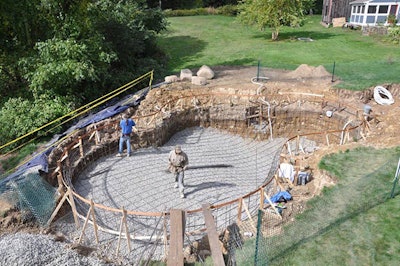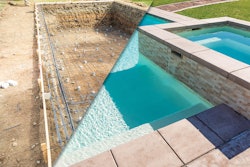
We all know how our industry promotes the joys of owning your own pool, whether it is aboveground or in-ground, but explaining the processes involved in achieving this vision for customers is critical. Customers need to know all of what is involved in order for them — and you — to have the least amount of stress and come out satisfied with the experience overall. At Rising Sun Pools & Spas, we follow these guidelines to mitigate customers’ reactions about what will happen during installation.
Timing Is Everything
We tell our customers right up front that from initial permitting and digging to completion, it'll take four to six weeks weeks on average to build their pool. All too often, customers believe they can wait until spring reach out to us about a new project and get their pool by Memorial Day weekend. They forget that pool companies have to balance their workloads for dozens of customers, and therefore it is first come first served, which can push installation well into the summer for those who delay. A good rule of thumb to follow is to begin your advertising and promotion for pool builds in the offseason, with messages that encourage customers to make installation plans now to avoid a pileup of requests once temperatures rise in March or April.
You should also mention the variability of weather. When there is a 30 percent or more chance of precipitation, we typically will not pour concrete because conditions exist that will not let the material settle. However, we will pour concrete those days only with the customer’s written consent and with the understanding that the process can end up delaying the project even more if rain does occur as predicted. This process will not only cover you but will also make the client realize how much weather plays in the construction process.
Emphasize Planning For Location
A big factor affecting construction time is a customer’s preparation about exactly where they want their pool placed. Simply saying “the backyard” does not help, particularly when people do not know the size of their lots. Additionally, a septic system can dictate what amount of land is available, as you have to avoid cutting lines, and easements can impact where you dig.
With that in mind, we tell customers to bring us a plat or site plan of their property that we can share with local zoning officials to see what will work best. Keep in mind that this review can take up to 10 business days and will not even involve permitting, but it can save everyone time in determining the right place and dimensions of what to build.
As for permitting, it varies widely among municipalities. Our policy is to wait until we get a building permit approved and in hand before putting a construction date on our calendar for a customer to avoid scheduling problems that will arise if the permit takes longer than anticipated. We let customers know that on average it will take up to three weeks for permitting.
Discuss the Impact of Construction
Heavy machinery and equipment will be necessary even for an aboveground pool for proper grading and digging of soil. That likely means dirt will be dropped on driveways, lawns will be chewed up and trucks will take up space. Many customers are surprised at the extent of what happens on their property during the construction phases of their pool.
To prevent such consternation, we review our activities with customers and have them sign a waiver indicating that while we intend to avoid malice on their land, we are not responsible for any damages incurred, such as driveway cracks. Some want restorative actions taken, so we agree to pressure wash their driveways and throw out grass seed to please them. These additional steps may inconvenience you in the short term, but in the long term it provides you with satisfied customers who will recommend you to others.
Don’t Forget Renovations
Beyond the initial construction of a pool, your customers will have to understand that while the typical warranty for a liner lasts 25 to 30 years, the liner probably will need to be replaced well before that deadline. Again, we tell ongoing customers during the winter to assess if such an upgrade is needed, because it will take at least six weeks for us to complete this task. With these customers, we inform them to pick out a new liner and choose any new accessories if desired to do an upgrade quickly and conveniently.
Providing your customers with realistic expectations comes down to honest communications. Reach out to them when they are not thinking about pools, explain the building process thoroughly and remain in touch as much as possible. By incorporating these measures into your business procedures, you should find that they make the building process move much more smoothly for everyone — especially yourself.











































